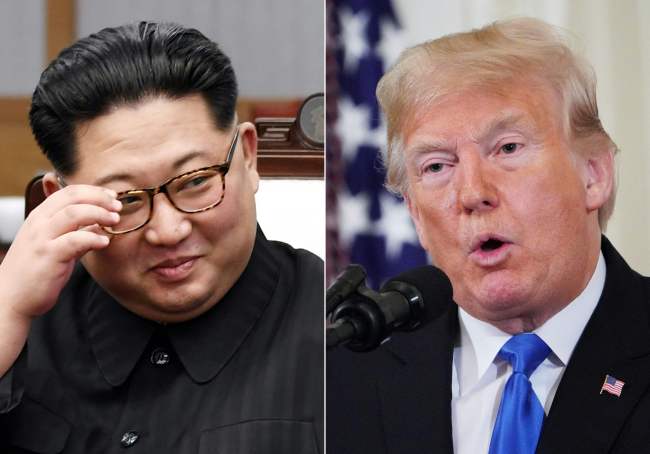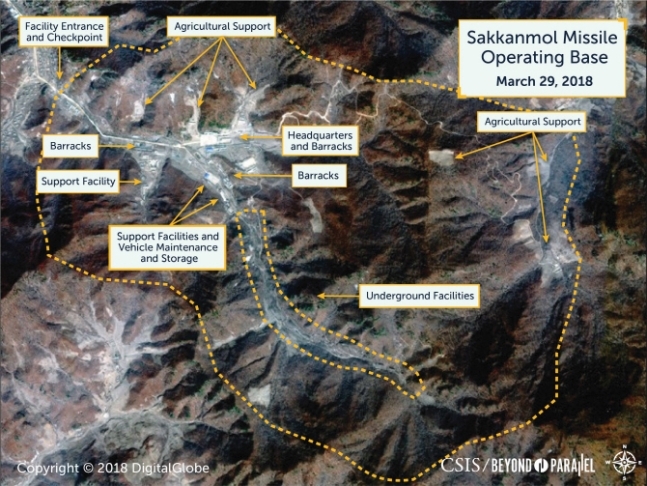A Washington think tank’s report about undeclared missile bases in North Korea has prompted debate over whether Pyongyang is keeping its promises to the US, with many commentators questioning how the controversy will affect denuclearization talks down the road.
Beyond Parallel, a team that specializes in North Korea issues at the US-based Center for Strategic and International Studies, said in its report published Monday that it has identified 13 out of an estimated 20 missile bases that North Korea has not declared.
Citing the report, the New York Times claimed North Korea has been operating 16 hidden bases for its ballistic missile program and that its leader Kim Jong-un broke the commitment made upon meeting with US President Donald Trump in Singapore in June.
“The satellite images suggest that the North has been engaged in a great deception,” the New York Times reported, citing satellite images of Sakkanmol base, one of the 16 “undeclared” missile bases in North Korea it mentioned
 |
North Korea`s leader Kim Jong-un(left) and US President Donald Trump. Yonhap |
While the CSIS report is indicative of the challenges in verifying hidden nuclear and missile facilities scattered around North Korea, analysts say the claim that Pyongyang has broken promises is biased hyperbole.
Considering that the existence of the Sakkanmol base had been well-known to intelligence agencies in the US and South Korea, experts noted that the timing of the report reflects the Washington establishment’s critical view of Trump’s rapprochement with North Korea.
Adding to the controversy is that the satellite images of the missile bases were captured well before Kim met with Trump. The pictures of the Sakkanmol base were taken in March, three months before the Trump-Kim summit.
“Technically speaking, it is not deception,” said Go Myung-hyun, a research fellow at the Asan Institute for Policy Studies. “North Korea has never promised a nuclear freeze. It only agreed to shut down a nuclear test site and a missile launch site.”
During the Singapore meeting with Trump, Kim pledged to work toward the “complete denuclearization of the Korean Peninsula.” In a good-faith measure, Kim offered to shut down a major missile launching site after closing down the Punggye-ri nuclear test site in May.
But those moves do not suggest that Kim is required to declare missile bases that the North wants to hide from the outside world, Go noted, because North Korea has never agreed to provide a full accounting of its nuclear arsenal to the US.
Leon V. Sigal, director of the Northeast Asia Cooperative Security Project at the Social Science Research Council, said the New York Times exaggerated what was originally said in the CSIS report by longtime North Korea watchers.
“The New York Times story is based on a careful report by Joseph S. Bermudez, Victor Cha and Lisa Collins that makes no such claim,” Sigal said in a commentary posted on the North Korea-focused website 38 North on Tuesday
Sigal said Burmudez, who serves as a senior fellow for Imagery Analysis at the CSIS, has long observed North Korea’s undeclared missile bases. Among the 16 undeclared missile bases, 13 were observed by Burmudez himself, Sigal said
 |
Yonhap |
The controversy appears to reflect the frustration of Washington’s foreign policy establishment, which is critical of South Korean and US leaders’ approach toward North Korea’s nuclear program.
In a tweet posted Wednesday, Victor Cha, a prominent North Korea expert who co-authored the CSIS report, hit back at Trump’s claim that the New York Times report was “fake news” and criticized South Korea’s presidential office for advocating North Korea’s position.
Trump lashed out at the New York Times on Tuesday, calling the newspaper’s report about North Korea’s missile bases “fake news.” South Korea’s presidential office, Cheong Wa Dae, dismissed the CSIS report as containing “nothing new.”
“How can the (South Korean government) defend NK’s undisclosed operational missile bases?” wrote Cha. “For the sake of ‘fake diplomacy’? Seriously, how contorted can these rationalizations for NK weapons possession get??”
Cha asserted that North Korea should provide a list of those “undeclared” missile bases, saying they are still operational and capable of launching ballistic missiles. North Korea was believed to have fired short-range ballistic missiles from the Sakkanmol site in 2016.
In a closed-door meeting with lawmakers on Wednesday, South Korea’s top spy agency said North Korea is believed to be continuing nuclear and missile activity even after the first US-North Korea summit in June.
Those findings could worsen the prospects of the already-stalled denuclearization talks and a second US-North Korea summit, as the Democrats, who took over the House of Representatives in the recent mid-term elections, ratchet up criticism of Trump’s North Korea policy.
“The CSIS report is a message not just to North Korea, but to Trump and South Korea,” said Go of the Asan Institute. “The alliance of technocrats in Washington and experts over North Korea policy will mount more pressure on Trump to come up with better deal with North Korea.”
(
jasonyeo@heraldcorp.com)





![[Today’s K-pop] Blackpink’s Jennie, Lisa invited to Coachella as solo acts](http://res.heraldm.com/phpwas/restmb_idxmake.php?idx=644&simg=/content/image/2024/11/21/20241121050099_0.jpg)



